Facts About Güveç
Güveç is a type of earthenware pot that’s a staple in Turkish cuisine, ideal for creating delicious casseroles and stews. These pots are typically broad and medium-tall, available in both glazed and unglazed varieties. One of the advantages of cooking with a güveç pot is that you often don’t need to add much, if any, extra liquid.
While you can technically prepare güveç dishes in any oven-proof pan, using a clay or earthenware pot is preferred. Why? Because it imparts a distinctive, earthy aroma to the stew that’s hard to replicate. The tradition of güveç cooking has spread across the region, with each country adding its own twist. For instance, in the former Yugoslavian region, it’s known as đuveč, in Bulgaria, it’s called Gyuvech, and in Greece, it’s referred to as giouvetsi. All these names trace back to the Turkish word güveç.
So, what’s in a typical güveç dish? Think of it as a hearty meat and vegetable stew, somewhat like ratatouille. Common ingredients include various meats (such as chicken, pork, lamb, beef, or even fish), olives, tomatoes, mushrooms, onions, herbs, and spices. It’s often served alongside a Balkan mixed salad, which is a delightful combination of roasted eggplant, sweet peppers, garlic, tomatoes, and a splash of vinegar. You’ll also find vegetables like zucchini, eggplant, peas, potatoes, and carrots in güveç dishes, all seasoned with paprika, summer savory, and other herbs.
Interestingly, the name đuveč refers to both the dish and the earthenware casserole it’s traditionally cooked in, stemming from the Turkish güveç. There are several variations of güveç dishes, such as Türlü güveç (vegetable stew), Kuzu güveç (lamb or mutton stew), Dana güveç (veal or beef stew), Karides güveç (shrimp stew), and Patlıcan güveç (eggplant stew). Whether you cook these dishes on the stovetop or in the oven, you’re in for a rich and flavorful meal.

 Georgia
Georgia